We all love to add art to the garden. Yet to do so correctly requires care, consideration and restraint. You want a garden that is enhanced by art but not cluttered by it, right?
As the lines between interior design and exterior design are blurred, we comfortably travel in and out of the garden. We bring the best of our landscape ideas indoors on a year-round basis, whether that means forcing branches to flower in late-winter arrangements or lining our windowsills with fresh herbs. Likewise, we extend home comforts outdoors, moving to garden rooms for peaceful pursuits or designing expansive patios to accommodate warm fireplaces or al fresco meals.
So for those with a garden lifestyle, furnishings and ornamentation have added importance, allowing us to appreciate everything from unusual artwork to flea market finds while enjoying them in relation to our plants. Here is how to make the most of ornamentation in the garden — taking an abundant approach.
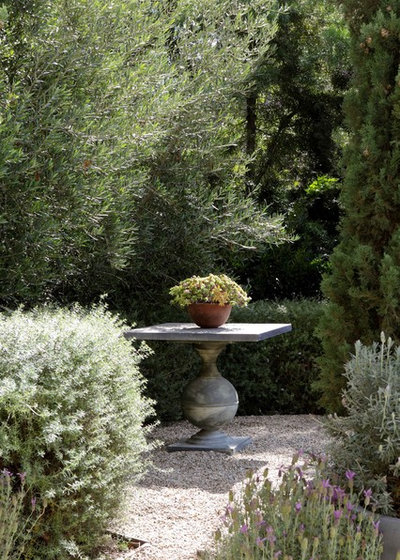
Studio William Hefner
Where and how we add objects show the value we give them. This classical stone-topped pedestal table is so perfectly proportioned and ideally suited for the garden niche it occupies. The designer has used ornamentation to paint an elegant, quiet scene in the landscape.
All of the tenets of good design are employed here, including the correct sense of proportion and scale. Outoors, the scale with which we work is seemingly endless, as the sky above is indeed vaster than any an interior ceiling.
Ornamentation must be substantial enough to stand up to the spaciousness of a garden. Here, that's exactly what's going on!
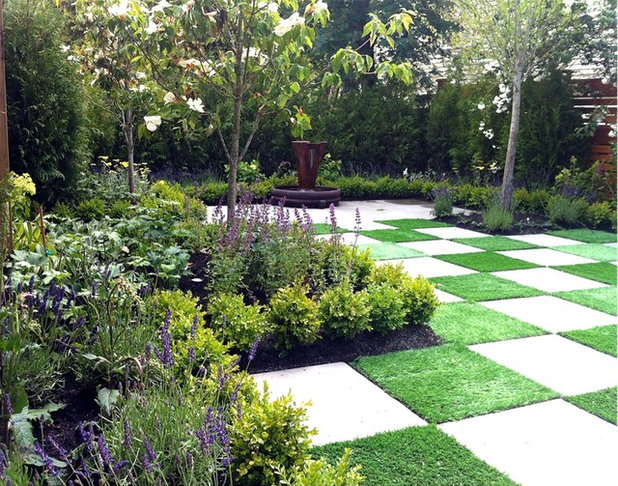
THOMAS KYLE: Landscape Designer
There are lawns. And then there are works of art.
Perhaps your rectangular patch of turf feels lush. But why not give it an artistic treatment, like this enticing
Alice in Wonderland–inspired checkerboard of grass and concrete pavers? (P.S. This lawn is durable, permeable and decorative — not to mention mowable!)
Remember: The nonplant elements and pieces that you incorporate into the garden should be a reflection of your personal style. At the terminus of this patchwork-quilted lawn is a gorgeous contemporary water feature. Unique and functional, it balances the two-dimensional "floor" with just the right three-dimensional form.
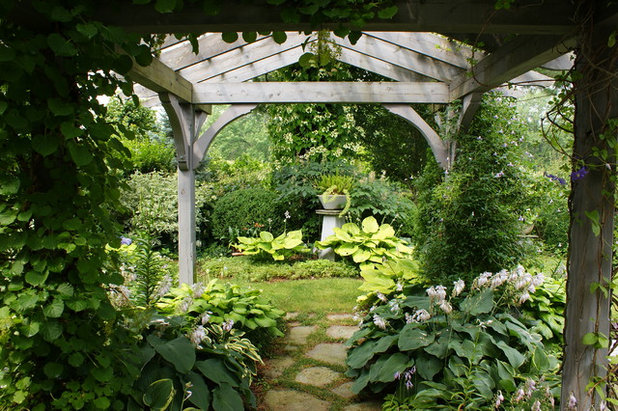
www.KarlGercens.com
Artwork in the garden should be highly personal. It can be anything from playful to restrained. Some gardeners take a curatorial approach to their ornamentation choices, isolating a cherished urn on a pedestal. Others prefer the organic approach of letting objects and plants happily commingle.
This scene is a happy hybrid. The architectural and sculptural design elements are surrounded by hostas, which are framed by a beautiful pergola and aligned perfectly with the stepping stone path. This is a composition of beauty.
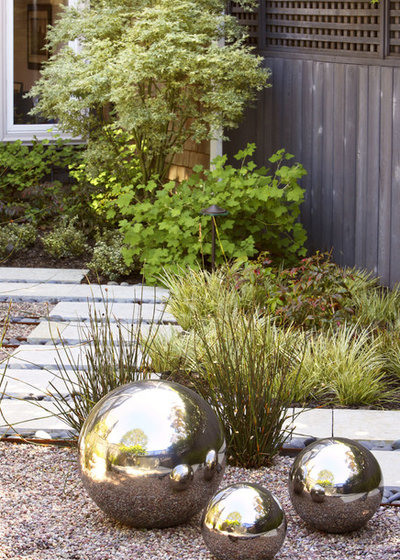
Arterra Landscape Architects
Plants and artwork should coexist compatibly, communicating the designer's intent. This alluring trio of gazing balls is thoughtfully placed, creating a noteworthy moment in the garden. The orbs reflect dazzling blades of grass as well as the texture and colors of the gravel flooring — there's an eye-catching counterpoint between shiny and dull.
Some gardeners are known to joke that while plants may be fleeting, artwork has permanence. That's a reassuring notion to keep in mind when choosing artful objects for your landscape.
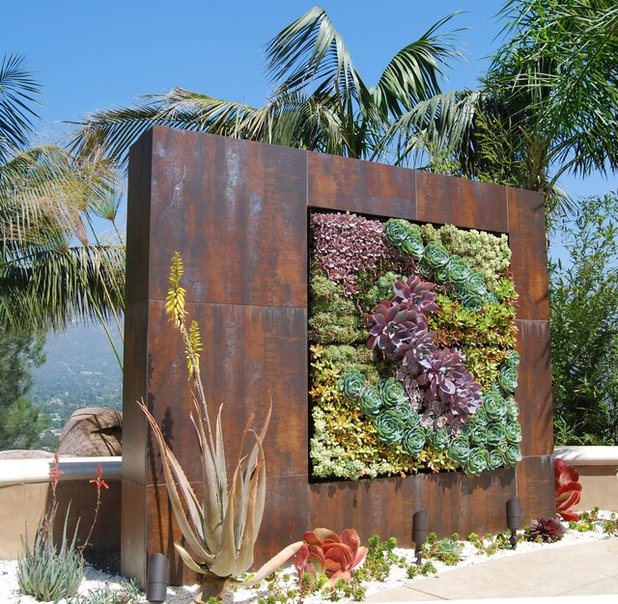
BlueGreen Landscape Design
Ornamentation in the landscape offers numerous ways to meet gardening challenges. For example, art can add interest to an otherwise unexciting corner or create privacy screening while also jazzing up the garden.
The succulent tapestry in this amazing weathered-steel wall is as stunning as any work of art in a gallery. It has been installed as a dramatic focal point. Notice the uplighting fixtures at the base of this piece, promising after-dark enjoyment of the patterned plantings. With hidden drip irrigation, it's also a low-maintenance design element that the owners can enjoy.
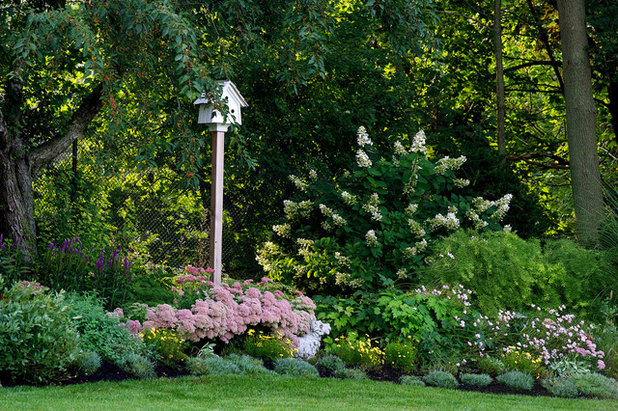
Amy Martin Landscape Design
Take your aesthetic cues from both architecture and landscape, selecting objects that speak to your garden's style. In this old-fashioned cottage garden, the birdhouse with white cladding feels just right. A stark, modern landscape would require something entirely different — perhaps a minimalistic bird feeder on a stainless steel post.
Devise an artistic hierarchy to guide your choices. How much attention should each piece command? Choose an appropriate setting for each inanimate object. You want to delight the viewers who catch a glimpse of the artful pieces. But you do not want to distract them from appreciating the overall beauty of the garden.

Between Naps on the Porch
There is definitely a place for the wacky or whimsical, like this bottle tree. Uninhibited works of art are ideal for the vegetable patch or the herb garden, where they are guaranteed to put a smile on your face each time you're harvesting salad ingredients.
Plant choices should show off the best of your ornamentation, adding up to an artistic sum that is more delightful than its individual elements. Similarly, if your garden requires something useful, like stakes to hold tall lilies or dahlias, choose supports that are both decorative and functional.
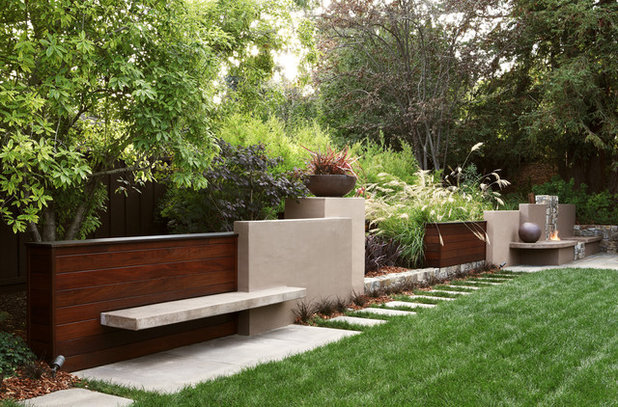
Arterra Landscape Architects
Your garden's hardscaping features can also be ornamental elements. Juxtapose textures and finishes, such as these dark ipe
hardwood planks, smooth sand-colored stucco and rugged stone.
Yes, this is a retaining wall, but it is an artful destination that offers garden seating and a fire element. The designer explains the intent: "Layered walls perform double duty as both sculpture and a way to define gathering spaces. Contrasting leaf textures and hues harmonize with the hardscape, and plant masses add their colorful statement."
What a creative solution that has elevated the once-ignored edge of a residential garden!
More: 10 elements of an abundant garden





